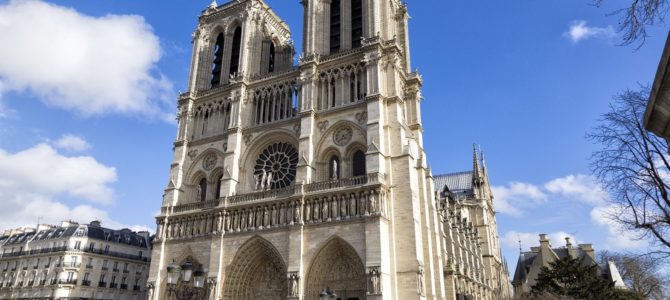
Yesterday, the world watched in horror as raging fire consumed much of the 850-year-old Notre-Dame de Paris Cathedral. In a stroke of mercy late on Monday evening in Paris, the fire officials declared that the main façade of the cathedral, containing the famed bell towers, would be spared.
Shortly thereafter it was revealed that even the central vault was largely still intact. The iconic spire, however, was completely destroyed, falling along with the majority of the roof into a pile of ashes.
Holy Week began yesterday, and many French and visiting Catholics watched as one of the most recognizable institutions of their faith was in danger of being annihilated after nearly 1,000 years on Earth. My colleague David Marcus wrote yesterday about Christ’s gift of mercy and grace, and the power of faith in God in the wake of this destruction.
In its 850 years, the cathedral has also become a symbol for much more. In its lifetime, it has seen the highest points and the darkest hours of France. It has become the visual symbol of the ability of Paris—and all of France—to survive revolution, cruel monarchs, wars, and country-wide occupation by Nazis. The 12 million annual visitors to Notre Dame serve as proof that it is much more than just a Medieval Gothic church. It is Paris.
It is perhaps the modern history of Notre-Dame that most clearly marks it as a symbol of Parisian strength and resolve. As it entered its 754th year in 1914, the Great War came to France and the famed bells of Notre Dame were silenced except for use as a citizen warning system.
The bells had been woven into the soundtrack of life in the City of Lights, and their silence did little to placate the anxiety during the war. On November 11, 1918, the bells rang out once more as the armistice was signed. People ran to the streets in jubilation. The cathedral had signaled the restoration of peace and prosperity in France.
Only a few decades later in 1940, as the dark cloud of Nazi Occupation settled in Paris, the bells of Notre Dame went silent once more. The symbol of life, of culture, of religious freedom, and of Paris itself was to be unheard for several years.
The French took early steps to protect the cathedral from Nazi looting, hiding large stained-glass pieces and many works of art. The occupation saw the life of French people deteriorate in an instant as families were torn apart, Jews were arrested and put on trains destined for concentration camps, and freedom was taken from every man, woman, and child.
The absence of the cathedral bells’ familiar chiming was coupled with more than four years of starvation, fear, and unrelenting Nazi rule. Following the 1944 arrival of the Allied army to France in the invasion of Normandy, Adolf Hitler placed Gen. Dietrich von Choltitz in charge of Paris with the order to destroy the city if the advancing Allies threatened to enter it.
Choltitz agreed to have the city wired for destruction by placing explosives in the most significant landmarks, including the Arc de Triumph, the Eiffel Tower, and the Notre Dame Cathedral. However, Choltitz knew the war was coming to an end and that he would not be on the winning side. He hoped the war would end somewhat peacefully, and he knew that the destruction of Paris, a city he loved, would mean his war would end in blood.
As the first of the Free French forces entered Paris under the command of Capt. Raymond Dronne, Parisians spread word quickly that liberation of their city was imminent. Messages were broadcast asking priests to once again ring the bells of their churches to signal to the Resistance and to the citizens that the Allies had arrived. Paris would be free. The bells of Notre Dame were the first to break the silence of persecution. They rang out in the sweetest song ever heard, joined by other bells from all over the city.
Choltitz called his superior, Gen. Speidel, and simply held the receiver of the phone to the window. The overwhelming sound of the bells did not require an explanation. Paris was no longer under Nazi control. Paris was free. Choltitz never gave the order to destroy the city.
The bells became an important symbol of the alliance between France and the United States once more, nearly 60 years later. On September 12, 2001, following the loss of almost 3,000 people in an unspeakable act of evil in the United States, the city of Paris closed the Metro so their citizens could pray. At Notre Dame, where many Parisians gathered, the bells began to toll in mourning.
The largest bell, Emmanuel, which had played the celebratory tones at the ends of both World Wars, was nearing 600 years of age and generally reserved for only a few annual holidays, state funerals, and visits from the pope. On September 12, however, for an entire hour Emmanuel and every other cathedral bell sang out in sorrow for the profound loss of life in America.
The cathedral of Notre Dame has been in Paris for most of a millennium. In just the last 105 years, it has become the symbol of life for the remarkable city. When times were grim, the cathedral’s survival served as a reminder that darkness is always followed by light. As the towers containing the iconic bells miraculously survived the fire, Parisians will soon hear them toll once more, and be reminded that the people of France have risen from the ashes many times, and now the cathedral will do the same.









